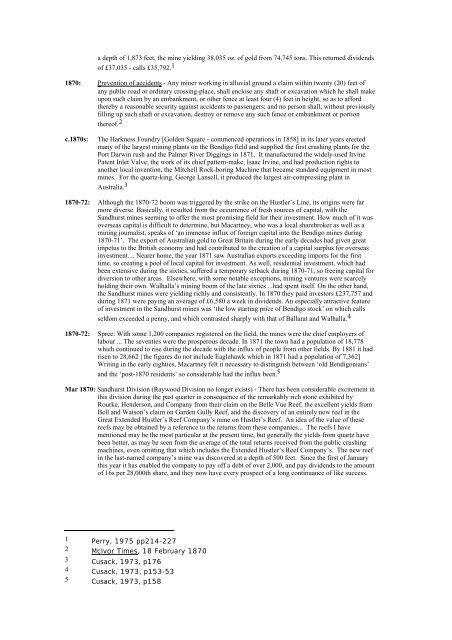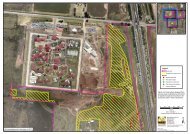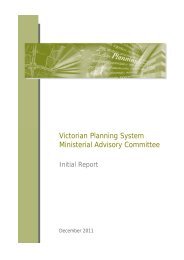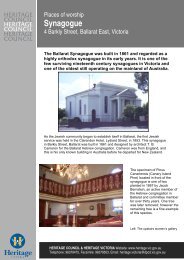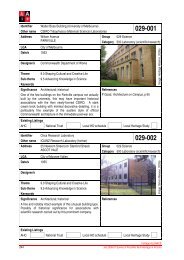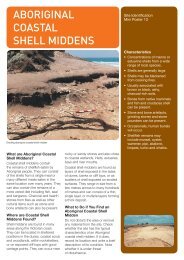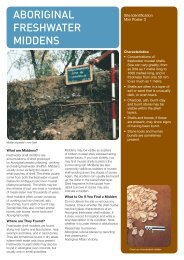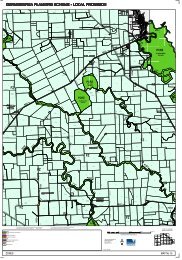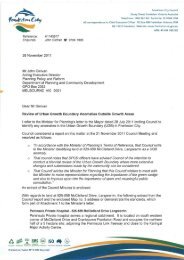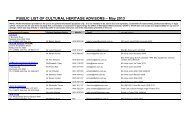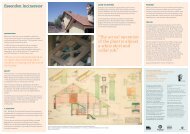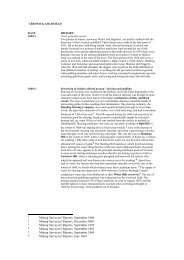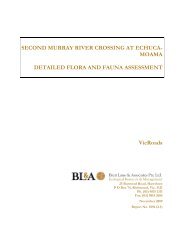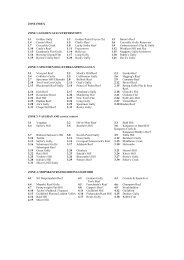Bendigo General History - Department of Planning and Community ...
Bendigo General History - Department of Planning and Community ...
Bendigo General History - Department of Planning and Community ...
You also want an ePaper? Increase the reach of your titles
YUMPU automatically turns print PDFs into web optimized ePapers that Google loves.
1870:<br />
a depth <strong>of</strong> 1,873 feet, the mine yielding 38,035 oz. <strong>of</strong> gold from 74,745 tons. This returned dividends<br />
<strong>of</strong> £37,035 - calls £35,792. 1<br />
Prevention <strong>of</strong> accidents - Any miner working in alluvial ground a claim within twenty (20) feet <strong>of</strong><br />
any public road or ordinary crossing-place, shall enclose any shaft or excavation which he shall make<br />
upon such claim by an embankment, or other fence at least four (4) feet in height, so as to afford<br />
thereby a reasonable security against accidents to passengers; <strong>and</strong> no person shall, without previously<br />
filling up such shaft or excavation, destroy or remove any such fence or embankment or portion<br />
there<strong>of</strong>. 2<br />
c.1870s: The Harkness Foundry [Golden Square - commenced operations in 1858] in its later years erected<br />
many <strong>of</strong> the largest mining plants on the <strong>Bendigo</strong> field <strong>and</strong> supplied the first crushing plants for the<br />
Port Darwin rush <strong>and</strong> the Palmer River Diggings in 1871. It manufactured the widely-used Irvine<br />
Patent Inlet Valve, the work <strong>of</strong> its chief pattern-make, Isaac Irvine, <strong>and</strong> had production rights to<br />
another local invention, the Mitchell Rock-boring Machine that became st<strong>and</strong>ard equipment in most<br />
mines. For the quartz-king, George Lansell, it produced the largest air-compressing plant in<br />
Australia. 3<br />
1870-72: Although the 1870-72 boom was triggered by the strike on the Hustler’s Line, its origins were far<br />
more diverse. Basically, it resulted from the occurrence <strong>of</strong> fresh sources <strong>of</strong> capital, with the<br />
S<strong>and</strong>hurst mines seeming to <strong>of</strong>fer the most promising field for their investment. How much <strong>of</strong> it was<br />
overseas capital is difficult to determine, but Macartney, who was a local sharebroker as well as a<br />
mining journalist, speaks <strong>of</strong> ‘an immense influx <strong>of</strong> foreign capital into the <strong>Bendigo</strong> mines during<br />
1870-71’. The export <strong>of</strong> Australian gold to Great Britain during the early decades had given great<br />
impetus to the British economy <strong>and</strong> had contributed to the creation <strong>of</strong> a capital surplus for overseas<br />
investment. .. Nearer home, the year 1871 saw Australian exports exceeding imports for the first<br />
time, so creating a pool <strong>of</strong> local capital for investment. As well, residential investment, which had<br />
been extensive during the sixties, suffered a temporary setback during 1870-71, so freeing capital for<br />
diversion to other areas. Elsewhere, with some notable exceptions, mining ventures were scarcely<br />
holding their own. Walhalla’s mining boom <strong>of</strong> the late sixties ...had spent itself. On the other h<strong>and</strong>,<br />
the S<strong>and</strong>hurst mines were yielding richly <strong>and</strong> consistently. In 1870 they paid investors £237,757 <strong>and</strong><br />
during 1871 were paying an average <strong>of</strong> £6,580 a week in dividends. An especially attractive feature<br />
<strong>of</strong> investment in the S<strong>and</strong>hurst mines was ‘the low starting price <strong>of</strong> <strong>Bendigo</strong> stock’ on which calls<br />
seldom exceeded a penny, <strong>and</strong> which contrasted sharply with that <strong>of</strong> Ballarat <strong>and</strong> Walhalla. 4<br />
1870-72: Spree: With some 1,200 companies registered on the field, the mines were the chief employers <strong>of</strong><br />
labour ... The seventies were the prosperous decade. In 1871 the town had a population <strong>of</strong> 18,778<br />
which continued to rise during the decade with the influx <strong>of</strong> people from other fields. By 1881 it had<br />
risen to 28,662 {the figures do not include Eaglehawk which in 1871 had a population <strong>of</strong> 7,362]<br />
Writing in the early eighties, Macartney felt it necessary to distinguish between ‘old <strong>Bendigo</strong>nians’<br />
<strong>and</strong> the ‘post-1870 residents’ so considerable had the influx been. 5<br />
Mar 1870: S<strong>and</strong>hurst Division (Raywood Division no longer exists) - There has been considerable excitement in<br />
this division during the past quarter in consequence <strong>of</strong> the remarkably rich stone exhibited by<br />
Rourke, Henderson, <strong>and</strong> Company from their claim on the Belle Vue Reef, the excellent yields from<br />
Bell <strong>and</strong> Watson’s claim on Garden Gully Reef, <strong>and</strong> the discovery <strong>of</strong> an entirely new reef in the<br />
Great Extended Hustler’s Reef Company’s mine on Hustler’s Reef. An idea <strong>of</strong> the value <strong>of</strong> these<br />
reefs may be obtained by a reference to the returns from these companies... The reefs I have<br />
mentioned may be the most particular at the present time, but generally the yields from quartz have<br />
been better, as may be seen from the average <strong>of</strong> the total returns received from the public crushing<br />
machines, even omitting that which includes the Extended Hustler’s Reef Company’s. The new reef<br />
in the last-named company’s mine was discovered at a depth <strong>of</strong> 500 feet. Since the first <strong>of</strong> January<br />
this year it has enabled the company to pay <strong>of</strong>f a debt <strong>of</strong> over 2,000, <strong>and</strong> pay dividends to the amount<br />
<strong>of</strong> 16s per 28,000th share, <strong>and</strong> they now have every prospect <strong>of</strong> a long continuance <strong>of</strong> like success.<br />
1 Perry, 1975 pp214-227<br />
2 McIvor Times, 18 February 1870<br />
3 Cusack, 1973, p176<br />
4 Cusack, 1973, p153-53<br />
5 Cusack, 1973, p158


